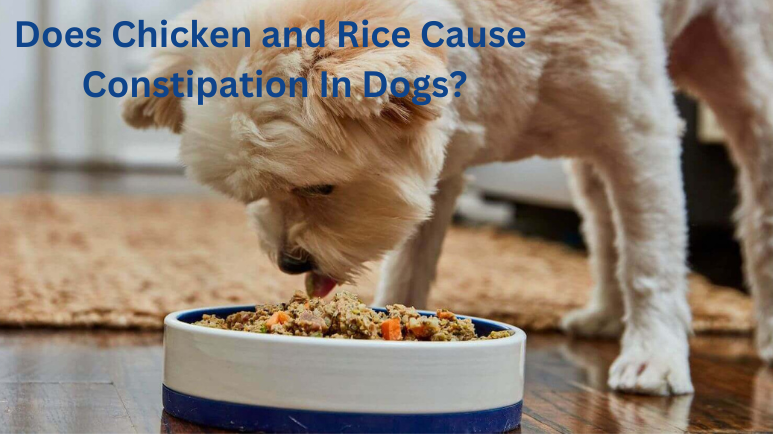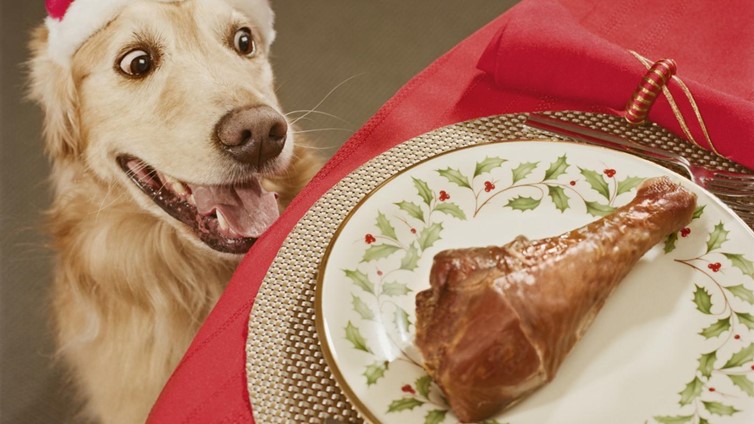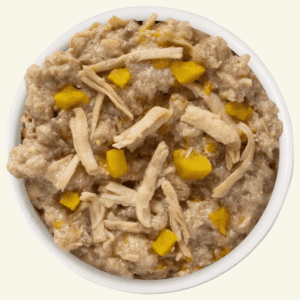One of the questions that many dog owners have is: does chicken and rice cause constipation in dogs? Constipation is a condition where a dog has difficulty passing stools or does not defecate for several days. Constipation can cause discomfort, pain, bloating, and loss of appetite in dogs. It can also lead to serious health problems if left untreated, such as intestinal obstruction, dehydration, or infection.
Some of the common causes of constipation in dogs are lack of fiber and water in the diet, ingestion of foreign objects, stress, lack of exercise, or underlying medical conditions. Some of the common symptoms of constipation in dogs are straining to defecate, hard and dry stools, reduced frequency of defecation, or blood or mucus in the stools.
Chicken and rice is a simple and bland meal that is often recommended for dogs with diarrhea or stomach upset. But can it also have the opposite effect and cause constipation in dogs? In this blog post, we will explore the benefits and drawbacks of chicken and rice for dogs, and suggest some alternatives to prevent or treat constipation in dogs.
The benefits of chicken and rice for dogs
Chicken and rice is a common and simple meal that many dog owners feed their dogs, especially when they have diarrhea or stomach upset. But what are the benefits of chicken and rice for dogs?
Essential nutrients and energy
Chicken and rice provide some essential nutrients and energy that dogs need for their health and well-being. Chicken is a good source of protein, which helps build and repair muscles, tissues, and organs.
It also contains amino acids, such as taurine, that are vital for the heart, eyes, and brain function. Rice is a good source of carbohydrates, which provide energy and fuel for the body. It also contains some vitamins and minerals, such as thiamine, niacin, iron, and magnesium.
Easy to digest and soothing
Chicken and rice are also easy to digest and soothing for dogs with diarrhea or stomach upset. Chicken is a lean meat that does not contain much fat or spices, which can irritate the digestive system.
Rice is a bland food that does not contain much fiber or gluten, which can cause gas or bloating. Together, chicken and rice can help restore the normal balance of the gut flora and reduce inflammation in the intestines.
Recommended by veterinarians
Many veterinarians recommend chicken and rice for dogs with diarrhea or stomach upset, as it can help them recover faster and prevent dehydration. Chicken and rice can also be used as a transition food when switching from one diet to another, as it can help prevent digestive problems caused by sudden changes in food.
Does chicken and rice cause constipation in dogs? However, veterinarians also advise that chicken and rice should not be fed for more than a few days, as it can cause other health issues if given for too long.
The drawbacks of chicken and rice for dogs
Whole chicken and rice can be beneficial for dogs with diarrhea or stomach upset, but it can also have some drawbacks if fed for too long or too often. Here are some of the reasons why chicken and rice can cause constipation or other health problems in dogs.
Low in fiber and water
Fiber and water are important for digestion and bowel movements in dogs. Fiber helps form soft and bulky stools that can pass easily through the intestines. Water helps moisten the stools and prevent dehydration.
Chicken and rice are low in fiber and water, which can make the stools hard and dry, leading to constipation. Chicken and rice can also reduce the intake of other foods that are high in fiber and water, such as vegetables, fruits, or canned food.
Possible side effects
Does chicken and rice cause constipation in dogs? and some other possible side effects, such as obesity, nutritional deficiencies, or allergies. Chicken and rice are high in calories and carbohydrates, which can lead to weight gain and obesity in dogs if not balanced with other foods or exercise.
Chicken and rice are also low in some essential nutrients, such as calcium, phosphorus, zinc, iron, or vitamin E, which can cause nutritional deficiencies or imbalances in dogs if not supplemented with other foods or vitamins. Chicken and rice can also trigger allergies or intolerances in some dogs, especially if they have sensitive stomachs or skin.
Risks of low-fiber dry food, excess bones, and fruit and vegetable peels
Some dog owners may think that they can prevent constipation in their dogs by adding some low-fiber dry food, excess bones, or fruit and vegetable peels to their chicken and rice diet. However, these foods can worsen the condition or cause other problems in dogs
Low-fiber dry food can dehydrate the dog and make the stools harder and drier. Excess bones can splinter and damage the dog’s mouth, throat, or intestines. Fruit and vegetable peels can contain pesticides, chemicals, or toxins that can harm the dog’s health.
The alternatives to chicken and rice for dogs
Whole chicken and rice can be a helpful meal for dogs with diarrhea or stomach upset, but it is not a complete or balanced diet for dogs. It is important to balance the diet of dogs with other sources of fiber and water, such as vegetables, whole grains, or canned food. These foods can help prevent or treat constipation in dogs by improving digestion and bowel movements.
Vegetables
Vegetables are rich in fiber, water, vitamins, minerals, and antioxidants that can benefit the health and well-being of dogs. Fiber can help form soft and bulky stools that can pass easily through the intestines. Water can help moisten the stools and prevent dehydration. Vitamins, minerals, and antioxidants can help boost the immune system and prevent diseases.
Some of the vegetables that can help prevent or treat constipation in dogs are:
- Carrots: Carrots are crunchy and sweet, which can appeal to many dogs. They are also high in fiber, beta-carotene, vitamin A, and potassium. They can help soften the stools and improve the vision and skin health of dogs.
- Green beans: Green beans are low in calories and high in fiber, vitamin C, vitamin K, and manganese. They can help fill up the stomach and regulate the bowel movements of dogs.
- Broccoli: Broccoli is a cruciferous vegetable that contains fiber, vitamin C, vitamin K, folate, and calcium. It can help prevent constipation and cancer in dogs.
However, you should also be careful not to feed too much or too raw vegetables to your dog, as they can cause gas, bloating, or choking. You should also avoid any vegetables that are toxic or harmful to dogs, such as onions, garlic, grapes, raisins, or mushrooms.
Whole grains
Whole grains are grains that have not been refined or processed, which means they retain their bran, germ, and endosperm. These parts contain fiber, starch, protein, vitamins, minerals, and phytochemicals that can benefit the health and well-being of dogs.
Fiber can help prevent constipation and lower the blood sugar and cholesterol levels of dogs. Starch can provide energy and fuel for the body. Protein can help build and repair muscles, tissues, and organs. Vitamins, minerals, and phytochemicals can help prevent diseases and inflammation.
Some of the whole grains that can help prevent or treat constipation in dogs are:
- Brown rice: Brown rice is a whole grain that contains fiber, complex carbohydrates, protein, vitamin B1, and vitamin B6.
What are some natural remedies for constipation in dogs?
Some natural remedies for constipation in dogs are:
- Pumpkin puree: Pumpkin is high in fiber and moisture, which can help soften the stools and regulate the digestive tract. You can add a spoonful of plain pumpkin puree (not the pie mixed with spices) to your dog’s food once or twice a day.
- Olive oil: Olive oil can act as a natural laxative and lubricate the dog’s digestive tract. You can add a teaspoon of olive oil to your dog’s food once a day.
- Ginger: Ginger can help soothe the stomach and stimulate bowel movements. You can add a small amount of grated ginger to your dog’s food or water, or make a ginger tea with chicken or beef broth.
- Oatmeal: Oatmeal is another source of fiber that can help prevent or treat constipation in dogs. You can cook some plain oatmeal and mix it with your dog’s food, or make oatmeal cookies with peanut butter and eggs.
- Psyllium husk: Psyllium husk is a natural bulk-forming agent that can increase the water content and volume of the stools. You can sprinkle some psyllium husk powder over your dog’s food, or mix it with water or broth.
These are some of the natural remedies that can help your dog get relief from constipation. However, you should always consult your veterinarian before trying any new home remedies for your dog, as some dogs may have allergies or sensitivities to certain ingredients.
You should also monitor your dog’s stool quality and frequency, and seek veterinary attention if your dog shows signs of severe constipation, such as vomiting, lethargy, loss of appetite, or blood in the stools.
Can I mix chicken and rice with canned food?
Chicken and rice can be a simple and nutritious meal for dogs, especially when they have an upset stomach or diarrhea. However, you may wonder if you can mix chicken and rice with canned food to make it more appealing or balanced for your dog. Here are some things to consider before doing so.
The pros of mixing chicken and rice with canned food
Canned food can be a good source of moisture, fiber, and other nutrients for dogs. It can also help prevent or treat constipation in dogs by softening the stools and hydrating the body.
Mixing chicken and rice with canned food can provide some benefits, such as:
- Adding variety and flavor to your dog’s diet
- Increasing the palatability and digestibility of chicken and rice
- Enhancing the nutritional value of chicken and rice
- Reducing the risk of overfeeding or underfeeding your dog
The cons of mixing chicken and rice with canned food
Canned food can also have some drawbacks for dogs, especially if fed too much or too often. Mixing chicken and rice with canned food can also pose some problems, such as:
- Increasing the calorie and fat intake of your dog
- Causing diarrhea, weight gain, or pancreatitis in your dog
- Creating nutritional imbalances or deficiencies in your dog
- Triggering allergies or intolerances in your dog
How to mix chicken and rice with canned food safely
If you decide to mix chicken and rice with canned food for your dog, you should follow some guidelines to do it safely and moderately. Here are some tips:
- Choose a high-quality canned food that is suitable for your dog’s age, size, and health condition
- Check the ingredients and nutrition facts of the canned food and avoid any that contain artificial colors, flavors, preservatives, or fillers
- Consult your veterinarian about the appropriate amount and frequency of feeding canned food to your dog
- Mix the chicken and rice with canned food in a ratio of 1/3 chicken and rice to 2/3 canned food
- Monitor your dog’s stool quality and frequency, weight, appetite, and energy level after feeding him the mixture
- Adjust the amount or type of canned food as needed based on your dog’s response.
How much chicken and rice should you feed your dog to prevent constipation?
Chicken and rice is a simple and nutritious meal that many dog owners feed their dogs, especially when they have diarrhea or stomach upset. Does chicken and rice cause constipation in dogs? How much chicken and rice should you feed your dog to prevent constipation? The answer depends on the size and age of your dog, the reason for feeding chicken and rice, and the duration of the diet.
The size and age of your dog
The amount of chicken and rice to feed your dog depends on the size and age of your dog. As a general rule of thumb, you should feed your dog one cup of cooked rice and one cup of cooked chicken per 25 pounds of body weight per day.. For example, if your dog weighs 50 pounds, you should feed them two cups of cooked rice and two cups of cooked chicken per day.
However, this is only a rough estimate and you may need to adjust the amount based on your dog’s individual needs and preferences. Some dogs may need more or less food depending on their activity level, metabolism, health condition, and appetite.
You should also consider the calorie content of the chicken and rice, as well as the other foods that you are feeding your dog. Chicken and rice are high in calories and carbohydrates, which can lead to weight gain and obesity in dogs if not balanced with other foods or exercise.
The reason for feeding chicken and rice
The reason for feeding chicken and rice to your dog also affects the amount that you should feed them. If you are feeding chicken and rice to your dog because they have diarrhea or stomach upset, you should feed them smaller and more frequent meals than usual.
This can help soothe their digestive system and prevent dehydration. You should also reduce the amount of other foods that you are feeding your dog, such as kibble, treats, or table scraps.
If you are feeding chicken and rice to your dog because you are switching from one diet to another, you should feed them a mixture of chicken and rice and their regular food. This can help prevent digestive problems caused by sudden changes in food. You should start with a ratio of 1/3 chicken and rice to 2/3 regular food, and gradually increase the amount of regular food until the chicken and rice is completely replaced.
The duration of the diet
The duration of the chicken and rice diet also affects the amount that you should feed your dog. Chicken and rice is not a complete or balanced diet for dogs, as it lacks some essential nutrients, such as calcium, phosphorus, zinc, iron, or vitamin E.
Feeding chicken and rice to your dog for too long or too often can cause nutritional deficiencies or imbalances in dogs. Therefore, you should only feed chicken and rice to your dog for a short period, usually no more than a few days. If your dog’s diarrhea or stomach upset does not improve after two or three days, you should consult your veterinarian for further advice.
If your dog’s diarrhea or stomach upset improves after two or three days, you should gradually reintroduce their regular food until the chicken and rice are completely removed.
Why did my dog stool orange after eating chicken and rice?
You may have noticed that your dog’s stool has turned orange after eating chicken and rice. This can be alarming, as the color of your dog’s poop can indicate their health status. Is chicken and rice causing this change? Or is there another reason behind it? Let’s find out.
The role of bile in stool color
Bile is a yellow-green fluid that is produced by the liver and stored in the gallbladder. It helps digest fats and gives the stool its normal brown color. When the food passes through the intestines, bile mixes with the waste and changes its color depending on the type and amount of food.
Chicken and rice are low in fat and high in protein and carbohydrates, which can affect the production and secretion of bile. This may result in less bile being mixed with the stool, making it lighter or orange.The role of beta-carotene in stool color
Beta-carotene is a pigment that gives many yellow and orange fruits and vegetables their color. It is also found in chicken and rice, especially if they are cooked with carrots, sweet potatoes, or pumpkin.
Beta-carotene may not be well digested by some dogs, and it may end up in their feces, changing its color. This is usually harmless and temporary, and it should go back to normal after the dog’s digestive system adjusts to the new diet.
The role of digestive problems in stool color
Digestive problems can also cause orange stool in dogs, especially if they are related to chicken and rice. Some dogs may have allergies or intolerances to chicken or rice, which can cause inflammation, irritation, or infection in the digestive tract.
Some dogs may also have decreased gut motility or slow gastric emptying, which means that the food stays longer in the digestive tract, where it may undergo bacterial fermentation or oxidation, changing its odor, consistency, and color.
How to prevent or treat orange stool in dogs
Orange stool in dogs after eating chicken and rice is not always a sign of a serious health issue. It may be a temporary and harmless side effect of a bland diet that is often recommended for dogs with diarrhea or stomach upset. However, if your dog shows other symptoms, such as vomiting, lethargy, loss of appetite, or blood in the stool, you should consult your veterinarian as soon as possible.
To prevent or treat orange stool in dogs, you should follow these tips:
- Feed chicken and rice to your dog only when they have diarrhea or stomach upset, or when you are switching from one diet to another
- Feed chicken and rice to your dog for no more than a few days, and gradually reintroduce their regular food
- Feed chicken and rice to your dog in a ratio of 1/3 chicken and rice to 2/3 regular food
- Choose high-quality chicken and rice that are cooked well and do not contain any bones, skin, fat, salt, or spices
- Avoid any foods that contain artificial colors, flavors, preservatives, or fillers
- Balance the diet of your dog with other sources of fiber and water, such as vegetables, whole grains, or canned food
- Monitor your dog’s stool quality and frequency, weight, appetite, and energy level after feeding them chicken and rice
- Adjust the amount or type of chicken and rice as needed based on your dog’s response.
Conclusion
In this article, we have explored the question: does chicken and rice cause constipation in dogs? We have learned that chicken and rice can be a helpful meal for dogs with diarrhea or stomach upset, as it can provide some essential nutrients and energy, and soothe the digestive system.
However, we have also learned that chicken and rice can cause constipation or other health problems in dogs if fed for too long or too often, as it can be low in fiber and water, and cause obesity, nutritional deficiencies, or allergies.
Therefore, the answer to the question is: it depends. Chicken and rice can cause constipation in dogs if they are not balanced with other sources of fiber and water, such as vegetables, whole grains, or canned food. These foods can help prevent or treat constipation in dogs by improving digestion and bowel movements.
However, chicken and rice can also prevent or treat constipation in dogs if they are fed moderately and safely, and supplemented with some natural remedies, such as pumpkin, olive oil, ginger, oatmeal, or psyllium husk.
Here are some tips on how to feed chicken and rice to dogs safely and moderately:
- Feed chicken and rice to your dog only when he has diarrhea or stomach upset, or when you are switching from one diet to another
- Feed chicken and rice to your dog for no more than a few days, and gradually reintroduce his regular food
- Feed chicken and rice to your dog in a ratio of 1/3 chicken and rice to 2/3 regular food
- Choose a high-quality chicken and rice that is cooked well and does not contain any bones, skin, fat, salt, or spices
- Consult your veterinarian about the appropriate amount and frequency of feeding chicken and rice to your dog
- Monitor your dog’s stool quality and frequency, weight, appetite, and energy level after feeding him chicken and rice
- Adjust the amount or type of chicken and rice as needed based on your dog’s response.
FAQs: Does Chicken and Rice Cause Constipation In Dogs?
- Q: Why is chicken and rice recommended for dogs with diarrhea or stomach upset?
- A: Chicken and rice a bland food sources that can provide some essential nutrients and energy, and soothe the digestive system. It can help restore the normal balance of the gut flora and reduce inflammation in the intestines.
- Q: How long should I feed chicken and rice to my dog to prevent constipation and other side effects?
- A: You should only feed chicken and rice to your dog for a short period, usually no more than a few days. If your dog’s diarrhea or stomach upset does not improve after two or three days, you should consult your veterinarian for further advice.
- Q: How much chicken and rice should I feed my dog?
- A: The amount of chicken and rice to feed your dog depends on the size and age of your dog, the reason for feeding chicken and rice, and the duration of the diet. As a general rule of thumb, you should feed your dog one cup of cooked rice and one cup of cooked chicken per 25 pounds of body weight per day. However, you may need to adjust the amount based on your dog’s individual needs and preferences.








